The Art of Handspinning Silk Fibre
Many hand spinners are comfortable spinning silk within a wool preparation, blended commercially or by hand with fibre preparation tools at home. Often, the thought of spinning silk on its own is daunting. There is an amazing variety of silks on the market for handspinners today! Some are rare, others more easily available and still others exciting and colourful. Here, we will explore the different types of silk that are available and some spinning tips for success. Instead of covering everything available on the market, since there may be particular preparations or types available to you that others don’t have access to, I will keep the conversation broader to capture the most common types of silks you will come across.
I stumbled across a story from ancient Chinese folklore: it started with an empress sipping her tea, and the cocoon fell from the tree above into her teacup. She pulled it out and began to reel the silk around her finger until the end, where she found the source: a larvae. She then went on to teach others, and it became widespread. There is also Vietnamese folklore that tells a story of a girl whose soul turned into a silkworm – I encourage you to go look these stories up. They are fascinating!
Let us begin with silk classification to help with some working knowledge of the types of silks available today.
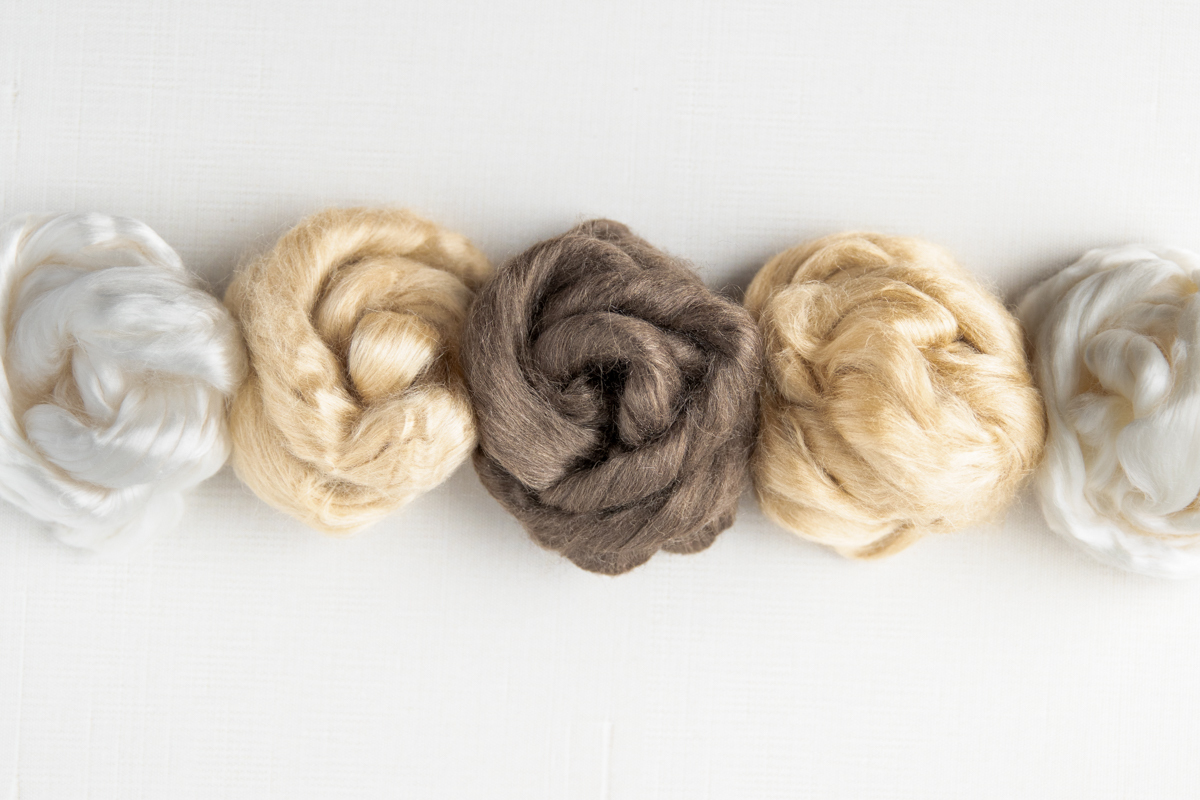
From left to right: eri, muga, tussah, mulberry, and peduncle silk.
Classification of Silk
Much like the new spinner coming to wool for the first time and thinking that the only breed of sheep is Merino, I came to silks with a similar mindset. Being open to the possibility that there was much to learn, I soon realized that not only was there an amazing variety of silks available on the market, one could make just spinning and studying silk their life’s work in handspinning. Much like the accomplished cotton or flax spinners, silk is a whole world unto itself. Really, spinning silk alone could be a whole mastery course.
Mulberry versus Wild Silks
Silk is classified as either Mulberry or Non-Mulberry. Mulberry silk is produced by the Bombyx mori moth, which eats a diet consisting of 100% mulberry leaves, hence mulberry silk. These moths are cultivated and completely depend on human intervention for their survival – they won’t even mate without being placed by hand on top of one another! The process of farming these moths is tightly controlled, right up to the harvest of the cocoons (Lamb, 2014). Because the process is so tightly controlled, these moths never experience the outdoors, instead being farmed and cared for inside.
The non-mulberry or wild silkworms live slightly differently when compared to mulberry silkworms. Some of the silkworms are left to live their life, being collected from the wild, while others are still farmed but in slightly less restrictive environments than the Bombyx mori silkworms (Lamb, 2014). The colour of silk depends on the leaves that the worms feed on. In the case of the Bombyx silkworms, the mulberry leaves they are given will determine the degree of both fineness and bright white colour that results (Lamb). The white mulberry leaves produce the finest and highest quality mulberry silk. I used to be quite confused between mulberry and tussah silk, but note that these are different silks, not to be confused with one another.
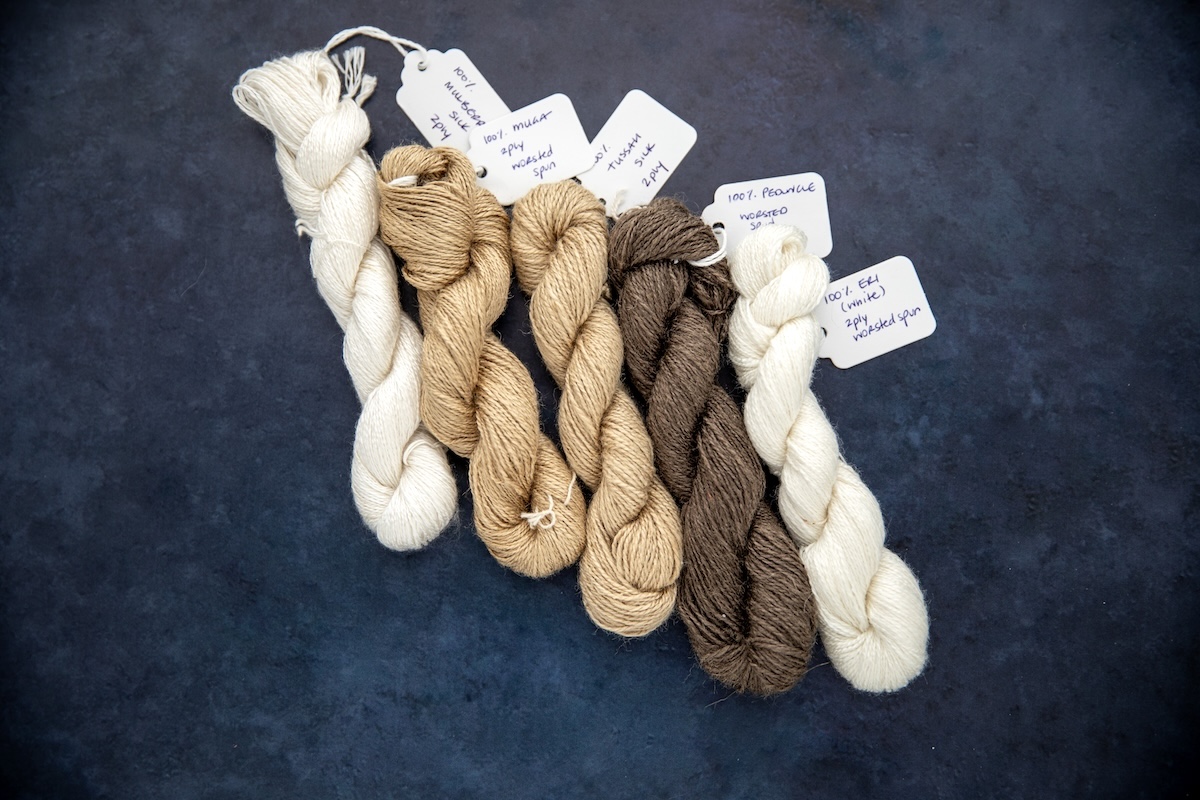
Tussah is the most common of the non-mulberry silk/wild silk that is cultivated now in China and Korea and possesses a more ‘golden or honey’ colour (Lamb, #16; Peigler, 2020). Tussah silk is cultivated from the silkworms Antheraea paphia, in India. It can vary from light creamy golden to dark brown, which we see in Tasar or Peduncle silk. The remaining wild silks originate from moths that are related to the Antheraea family of silkworms. While they all produce slightly different types of silk, and over time, favourites will emerge, none are as pure white or fine as the Mulberry silks from the Bombyx silkworms.
Spinning Silk for Success
There are many silks available on the market for handspinners. In the past few years, I have seen an uptick in the number of preparations, varieties and types of silks available on the market. I encourage you to experiment and practice with these different types as you have the opportunity. Here, we will discuss spinning the most common silks available, including Mulberry, Tussah, Tasar or Tussah Peduncle, Muga and Eri.
Generally, I have found a few approaches to spinning silk that work across the types and preparations. Because silk is a slippery fibre, lacking woolly scales and grip, the fibres themselves tend to slide over one another very easily and readily. Without grip, they don’t adhere or cling to one another readily, so they tend to stick to anything but themselves. Textiles that are worn while spinning will attract the silk quickly and, in my experience, can ruin or seriously compromise the preparation itself. Place a 100% silk cloth or ceramic plate on your lap instead to limit the fibres from adhering to your clothes!
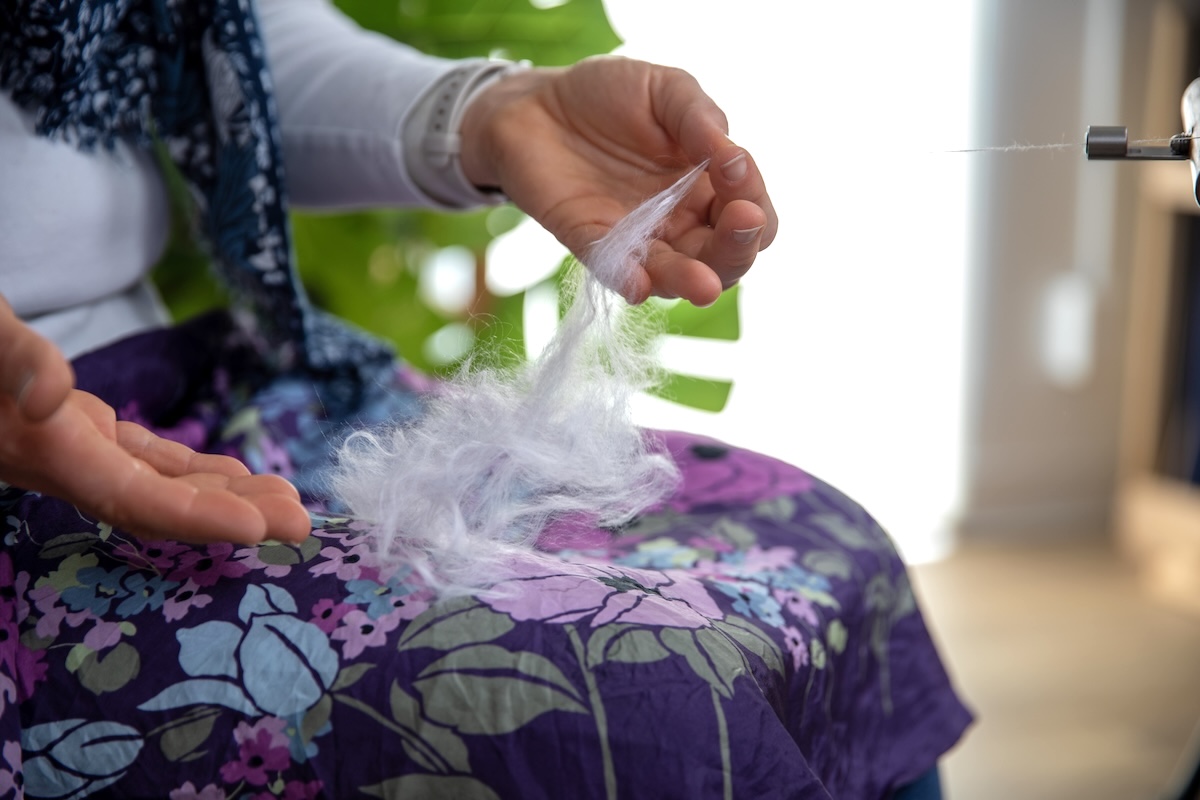
Because many of us tend to spin on spinning wheels, optimizing the wheel to work for spinning silk is a great place to start. If the wheel came with a smaller whorl, which allows a higher ratio (the number of times the flyer rotates for every single rotation of the drive wheel), more twist would enter the yarn more quickly. We will expand on this idea in a moment. In the meantime, there are also different brake systems associated with various wheels on the market. A double drive wheel can work quite nicely for spinning silk, as do Scotch tension brake systems. Scotch tension, also known as flyer-led wheels, is the most common brake system on the market, and most handspinners have a wheel that can be set in Scotch tension.
To set up the spinning wheel, I remove as much of the brake tension as possible. On a double drive wheel, the closer in size the whorl and bobbin whorl are, the less brake tension will be possible. As that difference increases, the more brake tension will be possible. Find a set-up that gives you enough brake tension to allow the singles to wind onto the bobbin but that the silk isn’t being ripped out of your fingers before enough twist has entered to create a structurally sound yarn. On a Scotch tension wheel, release the brake slightly to find that same amount of tension to allow the yarn to wind onto the bobbin without the silk being pulled from your hands. In my experience, a bobbin-led wheel or Irish tension doesn’t work super well for spinning silk due to the firm uptake that these wheels are known for. While they create some amazing yarns, needing lighter brake tension isn’t one of their strengths. Instead, opt for one of your other spinning wheels or adjust the drive band and brake to set up for Scotch tension or double drive since many wheels can be converted back and forth.
To briefly recap, we have our lap cloth or ceramic plate on our lap. We’ve released some of the brake tension, and now we are ready to get spinning. First, we will begin with Mulberry silk since it is widely available, and many handspinners have already spun it in commercially prepared wool-silk blends available widely on the market. This time, we are just going to spin it on its own.
Mulberry Silk: Brightest White
Mulberry is 100% cultivated silk from the moth Bombyx mori. Nowadays, this silk is completely cultivated, and the moths no longer live naturally in trees or the wild. Instead, they have been bred to be completely dependent on humans for their survival. Their cocoons, unless they are naturally coloured, as we mentioned previously, are the whitest of white. Because they have been manipulated to such a large extent, the silk that is produced by Bombyx mori is the most consistent and uniform. The sheen of the silk is the most uniform. Mulberry silk takes dye in the most vibrant way compared to the other silks due to its uniform quality and high reflection of light. If you have a chance to purchase some mulberry, play with both spinning it on its own and blending it with some wool to explore how the colours change. It won’t disappoint!
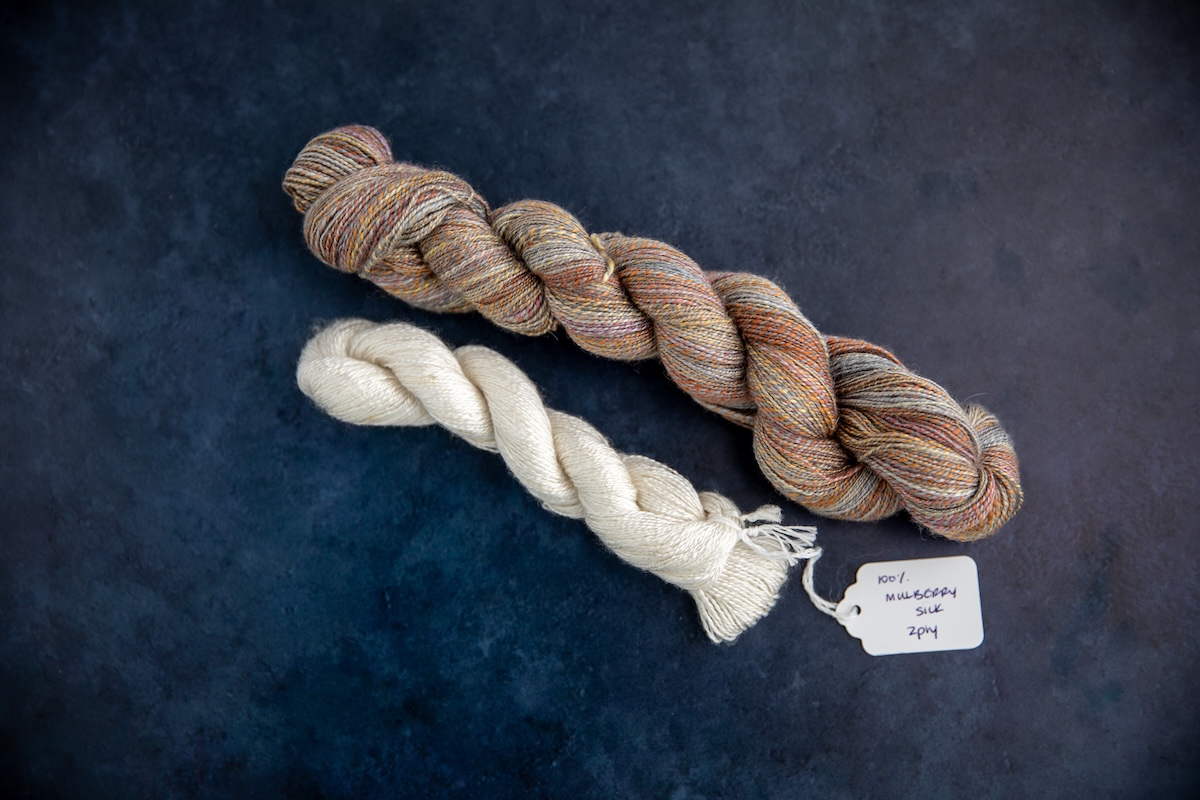
I like to strip the preparation down into thinner strips from the preparation to work with smaller amounts. I add a small amount of air by pre-drafting the fibres slightly and spin in a worsted fashion, keeping my fingers’ hold on the silk incredibly light, smoothing the fibres as I draft to create a smooth, dense yarn.
Tussah Silk: Wild Silk
Most handspinners have spun tussah silk, if not on its own, at some point in their spinning career because it is most often blended with wool. If a braid of handpainted combed top is labelled as a wool-silk blend, it is most likely tussah silk. In my experience, if the combed top is blended with Mulberry silk, the label will state this explicitly, and there will be a slight price difference.
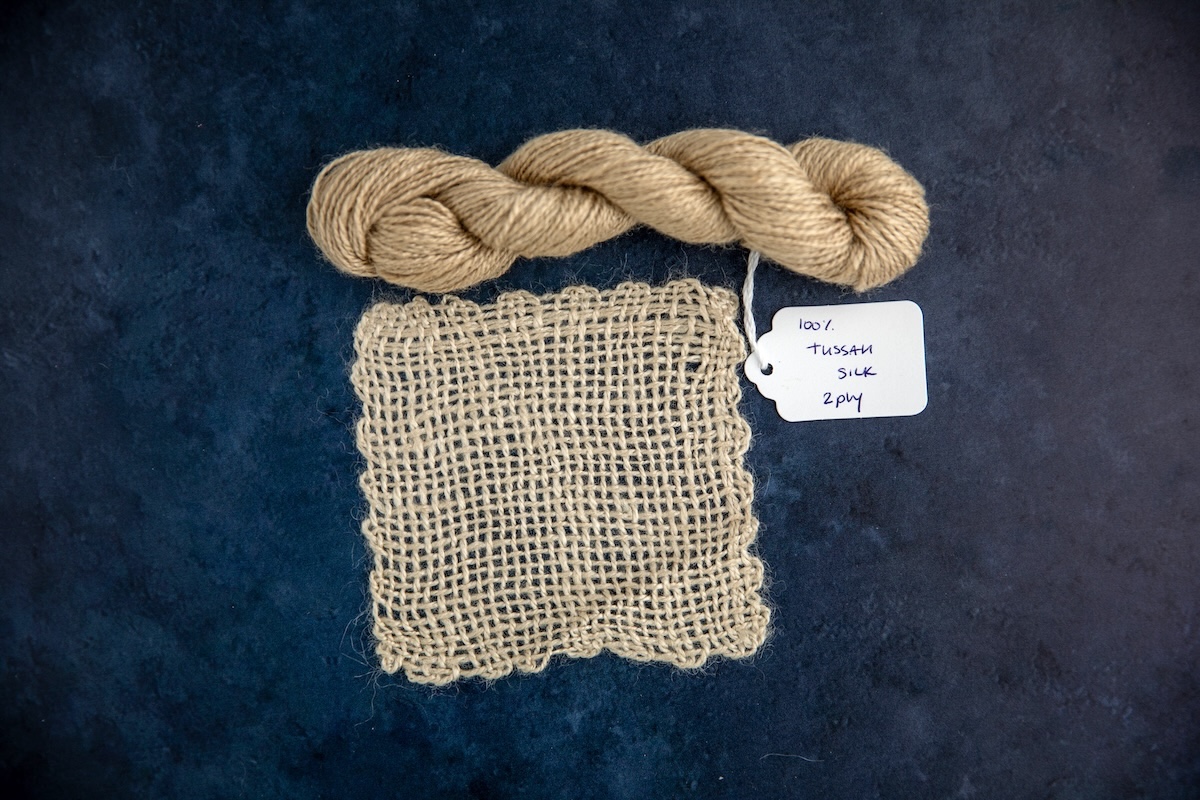
Tussah is available in different preparation methods, including laps, bricks, combed top and more. I have most often seen it in combed top. Like Mulberry silk, strip the silk down into manageable thicknesses for spinning. I like to put a very small amount of air into the top by pre-drafting it slightly. Too much, and it starts to fall apart. With the silk lapcloth or ceramic plate on my lap, I leave the lengths of Tussah in my lap, looped in loose nests. As I spin, I continue to check my ply-back tests to ensure I am placing enough twist into the singles. I am looking for those little beads along the singles that reflect the light beautifully.
Tasar or Tussah Peduncle Silk: Woolly Luxury
Tasar, sometimes spelled tassar or tussar, is part of the group of wild silks cultivated in India. These silkworms are part of the family Antheraea, usually called peduncle or Tussar silk when cultivated in China. The peduncle is the stem that the silkworm creates and attaches to the underside of the leaves. Peduncle silk includes this stem in its preparation, which creates a silk that feels textured.
What I loved about this particular silk spinning experience was the woolly nature of the fibres. Of all the silks, the peduncle spun the most as wool. It has a slight halo compared to the other silks, and I find it the most intuitive to spin of all the silks. Using a continuous backward draw, I find I can manage my spinning easily. This was an enormously enjoyable spinning experience. Enjoy the woolly nature of the tasar silk.
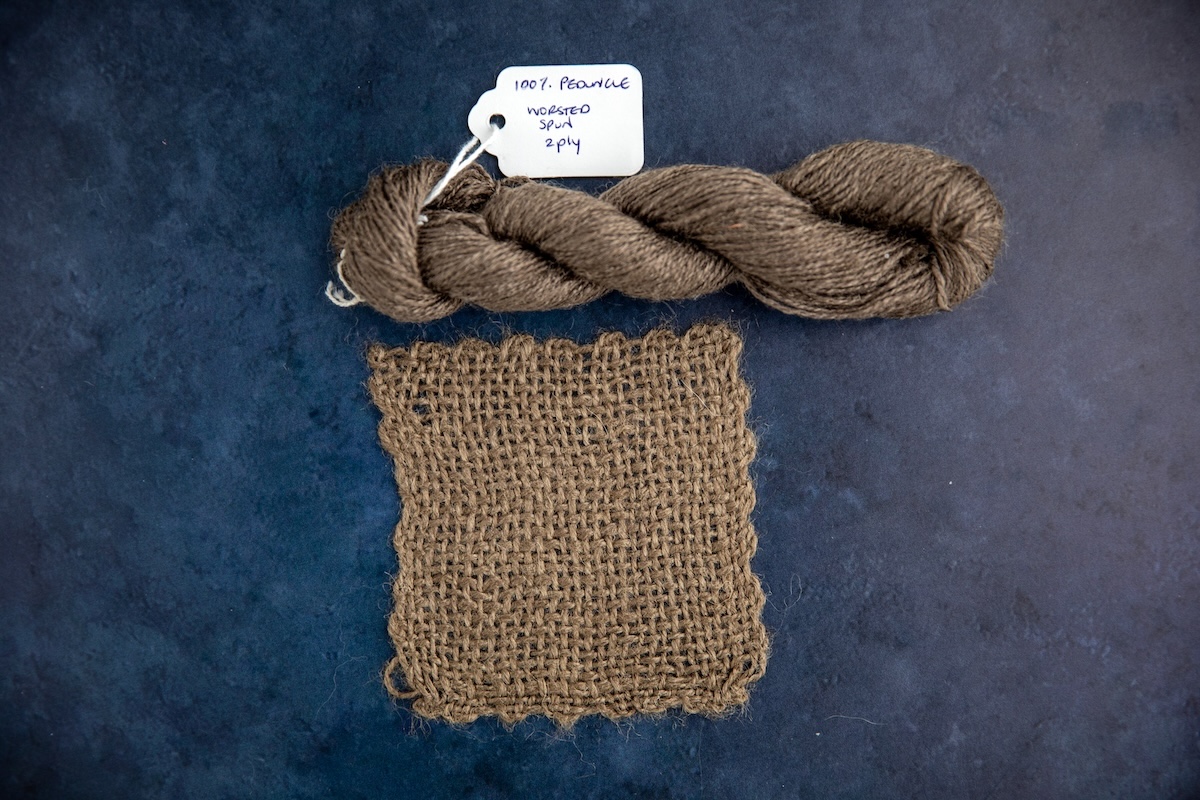
During spinning, note the halo of the fibres and the fine singles that are spun, even though the fibres themselves don’t feel as fine as some of the other silks. This is probably because the peduncle offers some slight texture in the spinning where there are places that necessitate going back and double-drafting. Double-drafting is a pause in the spinning when the spinner goes back to a section of singles and re-drafts or untwists the singles to draft slightly outward for consistency in the singles.
Muga Silk: Golden Luxury
The Muga has a lovely golden-coloured silk that spins like gold, literally. Muga is smooth and lovely. Muga is cultivated in India, namely in Assam. As part of a rural employment program, muga farming is being supported by the Indian government to raise the fibre and facilitate turning it into fabric (Lamb, 2014, p. 16). What is so interesting is that with a program like this, and others that exist for other types of fibres in other parts of the world, means that as handspinners, we might be able to have more and more access to high-quality spinning fibres alongside our beloved wools.
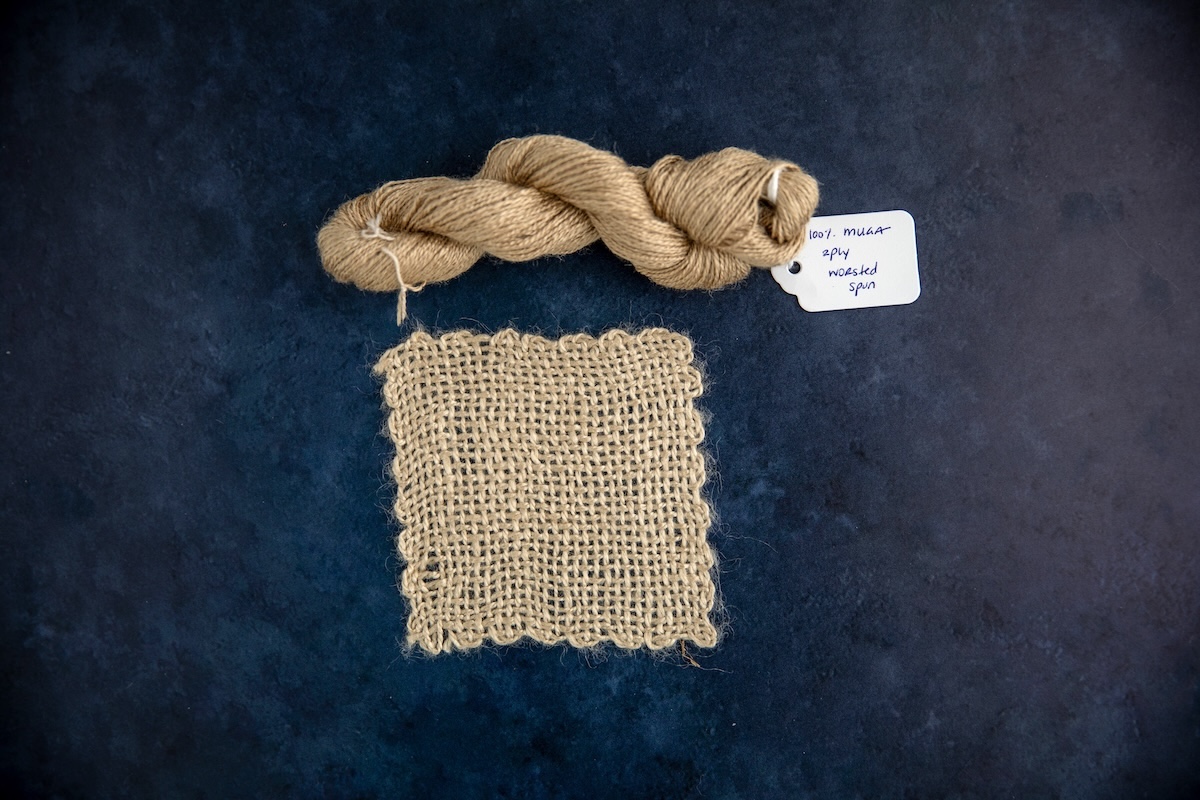
The silken nature of Muga feels slippery but just grabby enough that you can hang on to it without too much difficulty. I found it helpful to set up my wheel with a slightly lower uptake on the brake band. By stripping down the fibre horizontally, it becomes even easier to spin consistent singles with lots of twist to minimize fuzzing of the surface of the finished yarn. While it has been argued that low twist enhances the sheen, I have not personally found this to be the case. The high-twist silk yarns are very high lustre and sheen, remain hard-wearing and have a lovely hand to them.
Eri Silk: The Cotton of the Silk World
Of all the silks I have spun, this is probably the most challenging of the silks. There were several reasons for this, but namely, it is due to the fly-away nature of the Eri. I’ve seen Eri referred to as the ‘cotton’ of the silk world, and it seems to have a reputation for being a bit challenging to spin for that reason.
Eri, unlike the other silks, is harvested from the cocoon that must be flattened after washing, and the fibres are short for that reason. There is no reeling in the processing of Eri silks because these fibres are not filaments – they don’t have long, continuous threads that emerge from the cocoon (mueZart, 2019). Instead, the cocoons are flattened and feel like cotton to spin. Eri doesn’t crinkle in the fabric after knitting or weaving, which is very cool! It is soft and slightly rustic in nature, similar to the Tasar and wool.
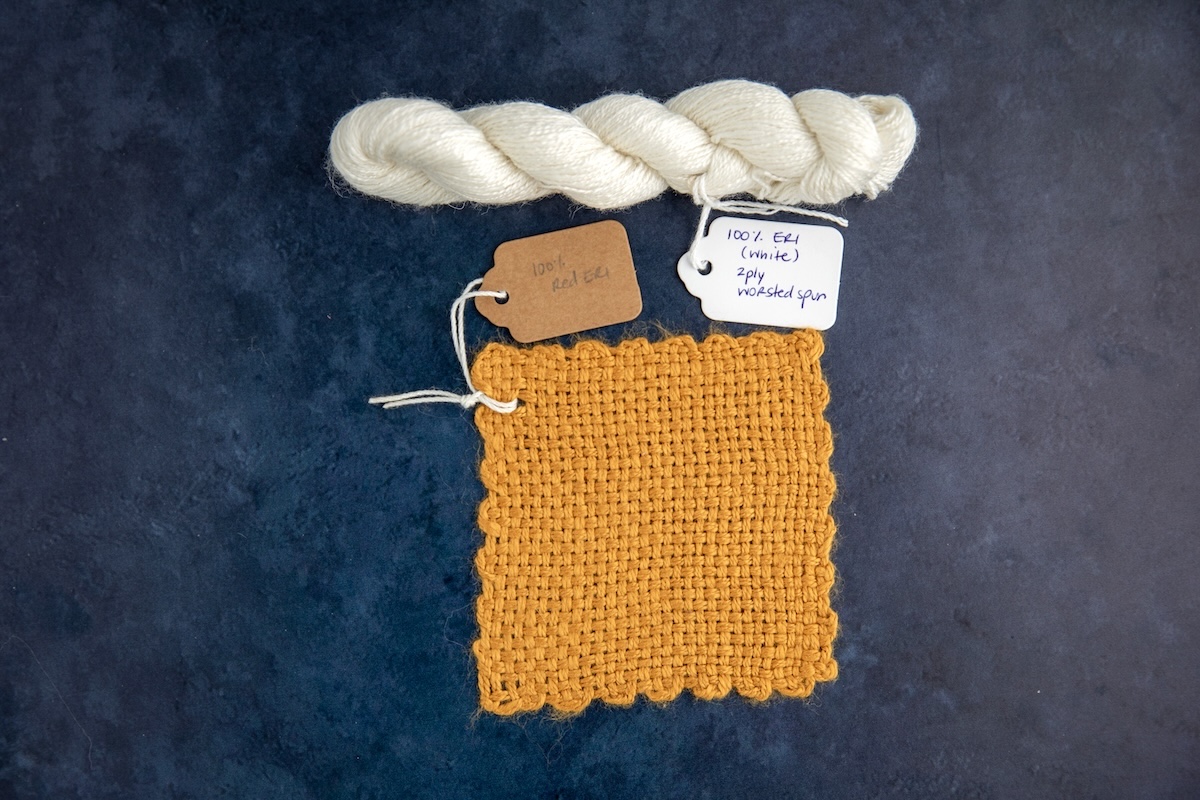
The Eri is most easily managed by ensuring that we don’t manage it much at all. As with all the silks, I didn’t pre-draft or attenuate the fibres at all, and the Eri seemed to just want to fall apart at anything close to this kind of fibre management. I actually found that even stripping the fibre caused it to fall apart, and I ended up making sure to handle it the least of all the fibres I spun. The sheen on this silk is notably less than the Mulberry and Tussah silks and creates a slightly duller surface. No less beautiful, to the untrained eye, they may think this is a high-sheen cotton, but of course, they’d be mistaken. I think this is why it is often compared to mercerized cotton.
Eri also requires a lot of twist due to the short-stapled nature of the fibres. They tend to adhere to everything but themselves, so spinning them with a higher twist helps the yarn remain structurally sound. Check ply-back tests regularly for twist and ensure you are treadling fast enough or using a smaller whorl.
Finishing Silk Yarns
To finish our silk yarns, we have to be very careful that we do not cause them to suede, which is when the silk fibres are irreversibly ruined in the washing process from water that is too hot. This often happens if silk yarns are boiled at high temperatures. Sometimes, there is sericin left on the silk fibres from the silkworms that needs to be degummed. There are some good resources out there to degum, and my favourite is Wormspit. The washing soda that is used in the process helps to dissolve the sericin off the silk, but due to the alkaline nature of washing soda, if left in the heat, it will damage the silk (Lamb, 2014). Rinsing very well immediately after the degumming process will help prevent any permanent damage to the fibre.
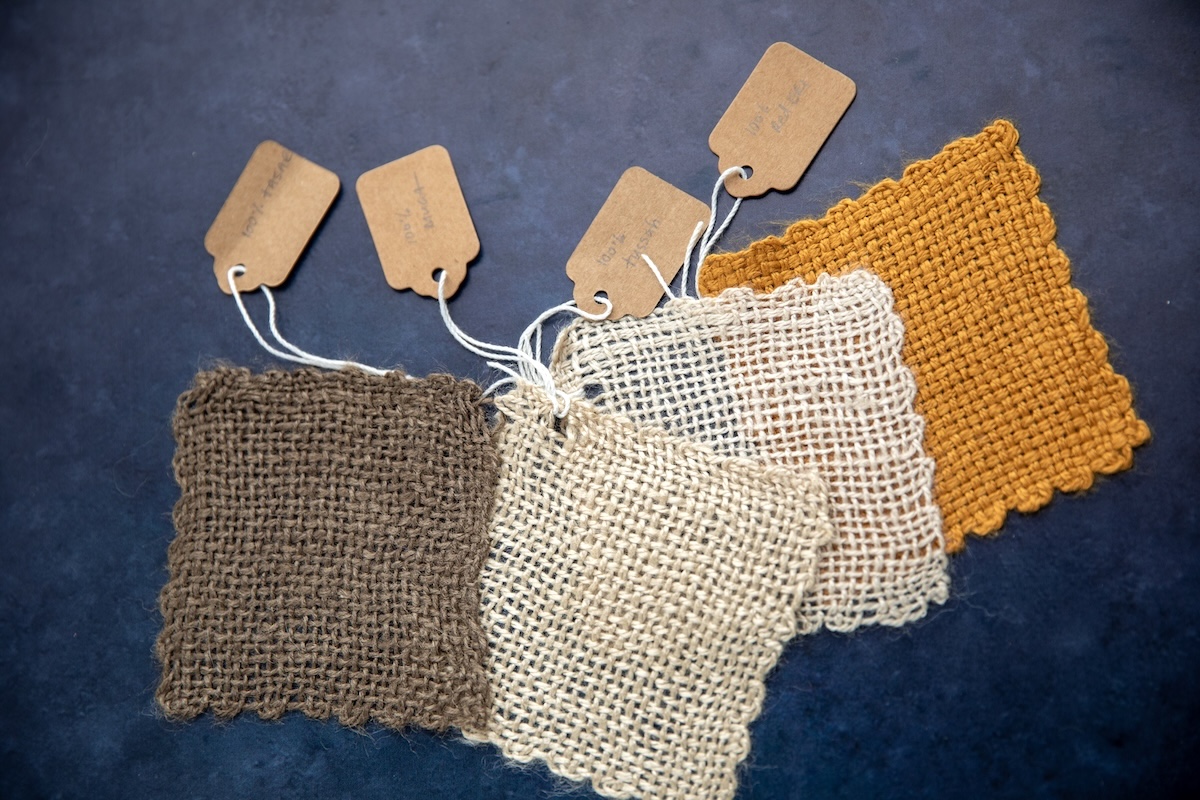
If the silk doesn’t need to be degummed, then a straightforward wash is all that is needed. According to my friend Kim McKenna, silk can take up to 12 hours for the water to fully penetrate the silk, so I tend to add warm water to a bowl with some gentle laundry soap, submerge the yarn and then swish it around to ensure the yarn is completely submerged and wet. I then set it aside and walk away. In all honesty, I often forget about it and don’t drain and rinse it until the next day. After rinsing it, I snap it gently and hang it to dry.
Working with silk offers a new and exciting challenge to hand spinning. While most of us have spun silk within commercially available blends on the market, many haven’t spun silk on its own. It deserves the spotlight! I encourage you to give it a try.
References & Resources
- The Practical Spinners Guide to Silk, Sara Lamb, 2014 (Interweave Press)
- The Intentional Spinner, Judith MacKenzie McCuin, 2009 (Interweave Press)
- Yarnitecture, Jillian Moreno, 2016 (Storey Publishing)
- Reeling Silk 101, Lee Juvan, 2008 (Knitty Magazine)
- Lustre: the untwisted truth, Coleen Nimetz, Ply Magazine, Issue 4, Spring 2014
- Wild Silks: their entomological aspects and their textile applications, Richard S. Peigler, 2020 (ScienceDirect)
- Combined Effect of Cameo2 and CBP on the Cellular Uptake of Lutein in the Silkworm, Bombyx mori, Wei, Wang, 2020
- Eri Silk Process Interview: Kongkiat Textile, KongkiatExport, 2017 (YouTube)
- Eri Silk- A Peaceful Silk in Assam, India, The Textiles Atlas
- Reeled, thrown, spun or raw, Cindy Myers (silkewerk)
- WormSpit, A site about silkworms, silkmoths, and silk
Explore more of Rachels’s articles here on SweetGeorgia and her courses at the School of SweetGeorgia!
The post The Art of Handspinning Silk Fibre appeared first on SweetGeorgia Yarns.
Comments
Post a Comment